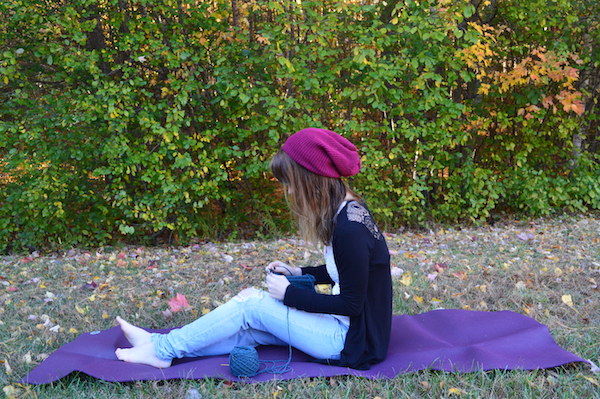
The forecast for a breakup typically includes a high probability of drunken states, with a mix of rain showers from individuals whose names you can’t recall.
In my case, it means attending an elderly woman’s knitting group once a week.
I am no stranger to using random men and empty liquor bottles to try to heal from a break up—the truth is, this coping mechanism marks my history more times then I’d like to admit. There were different men, but the results were always the same: the fulfillment they could provide me with lasted about as long as it took them to climax—about two minutes. Each encounter would leave me in an unrecognizable state of self-loathing and shame until I found my escape from that by leaping into the arms of the next wrong-for-me person.
After my most recent relationship ended, I chose to engage in an activity that I thought represented utmost purity and abstinence: a woman’s knitting group for seniors. I knew that the only needles and balls I’d be using would be for knitting a coaster.
(Forgive me for the Christmas gift plot-spoiler.)
A little more about me: I’m 26, and prior to this I’d never knit a day in my life.
Every Wednesday, the local senior center hosts a group of about 20 women with names that many of us millennials now have as middle names—for once in my life, “Patricia” is socially acceptable. Not only that, but these women had no idea who or what Patty Mayonnaise is, so there was no opportunity for it to be used against me.
(Curse you Patty Mayonnaise for making my middle school years hell! As if having braces and being flat chested wasn’t punishment enough.)
The attendee’s shared a median age of 70 and came loaded with an array of knitting supplies in their fanny packs or cat embroidered sacks. Hmmm, the outlier in this equation was quite obvious as I was not equipped with hearing devices, walking supports, musky perfume, and/or oversized spectacles—-and have I mentioned I’m 26 years old and don’t know how to knit?
What transpired in weeks to come was better then I could have imagined. My wildest dream as a little girl was coming true, right before my eyes! I had acquired about 20 different grandmas, who all poured their love, wisdom, and good food over me week after week. Fun fact: I have more canned goods to last a lifetime and I may or may not have gained 10 pounds.
They all took it as their responsibility for the preservation of knitting’s sake to ensure that I would become fluent with needles and yarn. Plus, their 20-something-year-old grandkids had no interest, as it did not involve electronics or hanky panky (their words, not mine). I felt I was receiving sacred texts when I was entrusted with their knitting patterns. The patterns given to me had been in some of their families’ lineage for generations and served purposes beyond superficial or “crafty” measures.
Knitting was essential to ensure survival and continuation of one’s bloodline, as items were needed to provide warmth during the depression or during the voyage when immigrating to America. Learning about the detailed and rich stories behind the patterns promoted a mystical experience that allowed me to evoke a deeper connection with the craft.
The first and most essential step in the knitting process is “casting on,” which means placing your first stitches on the needle to begin your work. If it is not done properly, rows will be in disarray and of no use. I struggled most with this maneuver, I often requiring guidance and support, as well as many “do-overs.”
The monotony of having to continually recast my projects and never relish in their completion was enough to drive me mad.
There were moments I was uncertain if I wanted to continue or just abort the whole project and sometimes even knitting itself. I just wanted to complete a coaster and it was as difficult as landing a secure relationship—mission impossible.
Through painful periods of introspection I had come to realize that my struggles with the first and most essential step in knitting was very representative to my life. I would hastily rush into relationships for instant gratification of love (or the disillusionment of so) and disregard myself in the process. I would settle for individuals who possessed qualities of opposition against my own moral compass but then rationalize it with, “but he loves me.” That infrastructure, or lack their of, would leave me in irreparable ruins—every time.
I am now learning that I need to take the time necessary to nurture myself and seek council to ensure the foundation I lay is indestructible.
Spending time and developing relationships with women who were at the last quarter of their life taught me important lessons about how to live a fulfilling life. I was able to vicariously live through their mistakes, shortcomings, missed opportunities, and unfulfilled dreams.
I was reminded that our time is finite and that “impossible” is just a word.
My knitting class did not allow me to solve all the mysteries and problems of the world or reach some state of transcendental enlightenment. My human journey is still filled with daily struggles and constant battling of my inner demons. But one thing’s for sure: I now know how to cast on with ease, and my foundation is solid enough to ensure that my future endeavors will be tightly and securely woven together.
Knitting means unity—and for once I have found that within myself.
Author: Autumn Colby
Image: Author’s own
Editor: Renée Picard










Read 3 comments and reply